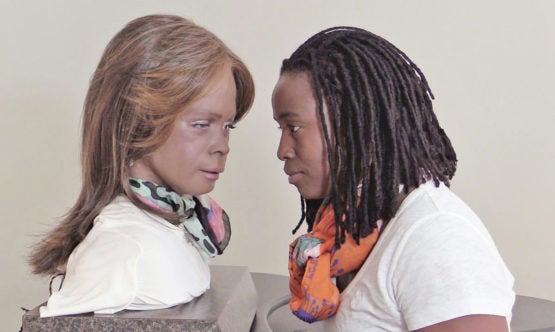Stanford University announces collaboration with Sundance Institute New Frontier Lab Programs designed to heighten creative visibility in underrepresented sectors
Sundance New Frontier Story Lab Fellow Stephanie Dinkins will further develop the “mind” of a learning artificial intelligence entity while on campus.
Stanford’s new Institute for Human-Centered Artificial Intelligence (HAI), an interdisciplinary, global hub for artificial intelligence thinkers, learners, researchers, developers, builders and users, is co-hosting its first HAI resident artist. The residency is a collaboration with Sundance Institute’s New Frontier Lab Programs (NFLP), and co-hosts on campus are the Office of the Vice President for the Arts (VPA) and the Stanford Humanities Center.

Transmedia artist Stephanie Dinkins pictured with an earlier AI project, the social robot Bina48. (Courtesy of Sundance Institute)
Transmedia artist Stephanie Dinkins will be on campus for a residency in the fall, developing her project Not the Only One, a multigenerational memoir of one black American family told from the “mind” of an artificial intelligence entity with an evolving intellect.
She will return in April 2020 for a convening of thought-leaders exploring artificial intelligence, automation, machine learning and culture. Stanford will also host an artist intensive of Sundance-supported artists working at the intersection of AI and identity.
“At Stanford HAI, we believe technology should improve the human condition,” said Fei-Fei Li, co-director of Stanford HAI. “If we want technology to serve humanity, the creators and users of technology need to be representative of humanity. Interdisciplinary collaboration is central to all of our work at HAI.”
“So much of the discussion about technology today is narrowly focused on algorithms,” she said. “We need a broader discussion – something deeper that is linked to our shared future. We are proud to host a residency for Stephanie Dinkins and support the New Frontier Lab Programs in the hope that it helps to bring more people into the discussion and expand our collective mindset.”
Stanford HAI is committed to studying, guiding and developing human-centered AI technologies and applications. It was founded on a belief that AI should be collaborative, augmentative and enhancing to human productivity and quality of life. HAI leverages the university’s strength across all disciplines, including business, economics, education, genomics, law, literature, medicine, neuroscience, philosophy and more, and complementing Stanford’s tradition of leadership in AI, computer science, engineering and robotics.
The collaborative artist residency emerged as part of Sundance Institute’s ongoing NFLP and the “Making a New Reality” multi-year research program, and is meant to deepen relationships with institutions already engaged in examining the intersection of art and new media, including artificial intelligence and virtual reality. Artist advocacy and exploration form the core of the endeavor, with a focus on social impact and inclusivity – all of which are in alignment with Stanford’s HAI, VPA and Humanities Center.
“New Frontier is dedicated to expanding opportunities for its diverse slate of fellows and collaborators bridging the divides between science, technology and story,” said Ruthie Doyle, interim director of NFLP. “By partnering with the country’s leading universities, we hope to further critical conversations about social impact and equity when it comes to the development and application of emerging technologies across a wide range of evolving practices.”
Dinkins uses lens-based practices, emerging technologies and community engagement to confront questions of bias in AI, consciousness, data sovereignty and social equity. She creates platforms for dialogue about artificial intelligence as it intersects race, gender, aging and our future histories. She is drawn to work with communities of color with an eye toward creating inclusive and ethical artificial intelligence ecosystems. Dinkins earned a Master of Fine Arts degree from Maryland Institute College of Art and is an alumna of the Whitney Independent Studies Program and is currently teaching in the Department of Art at Stony Brook University.
Dinkins said of the work-in-progress that is the focus of her residency at Stanford HAI, “Not the Only One (N’TOO) is an experimental, voice interactive AI memoir based on oral histories gathered from my family that I have been working on for a few years now. The project sits at the intersection of art, artificial intelligence and social justice practices. I can’t think of a more appropriate place to expand and improve the way N’TOO learns from and communicates with people than the Stanford Institute for Human-Centered Artificial Intelligence.”
Sundance Institute’s NFLP is for artists seeking to evolve or expand their creative practice in future-looking realms of narrative endeavor, utilizing advanced new technologies, like AI, biotech, XR, visual aesthetics, social media cultures, game theory and activism. NFLP identifies and fosters independent artists and creative technologists innovating the art and form of story at the convergence of diverse forms of creative expression; and builds a community of collaborators across disciplines to push the boundaries of story, and to imagine and enact the action needed for an inclusive future. The Sundance Film Festival has hosted an annual exhibition of cinematic innovation since 2007.”
“We are in the midst of an urgent and monumental window of transition in the architecture of our media landscape, one in which independent expression, social justice and our ability to know ourselves are held in the balance,” said Shari Frilot, New Frontier’s chief curator. “New Frontier is, fundamentally, a world-building project that aims to increase the capaciousness of our storytelling culture by supporting, and provoking, formal innovation and diverse interdisciplinary creative practice. These important collaborations effectively work to expand beyond the conventional imaginations and machineries that encrust traditional forms of storytelling so that vibrant, new realities can be created.”
